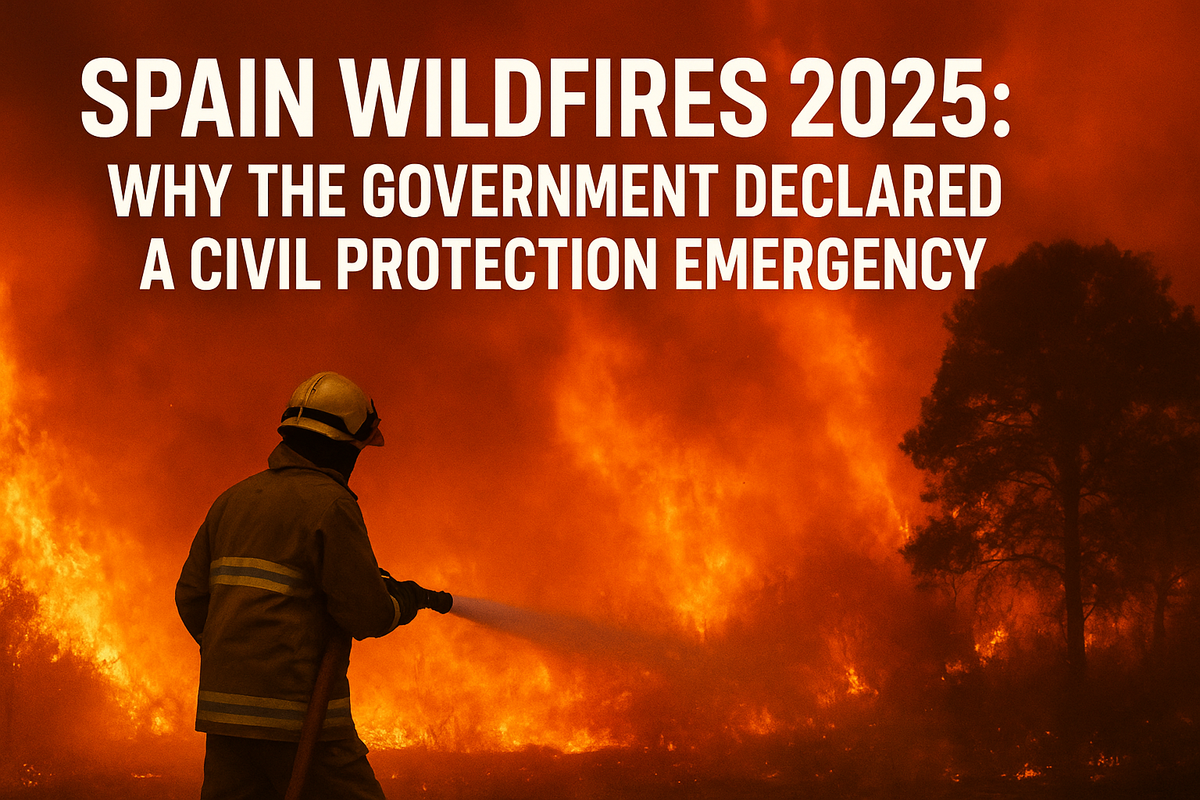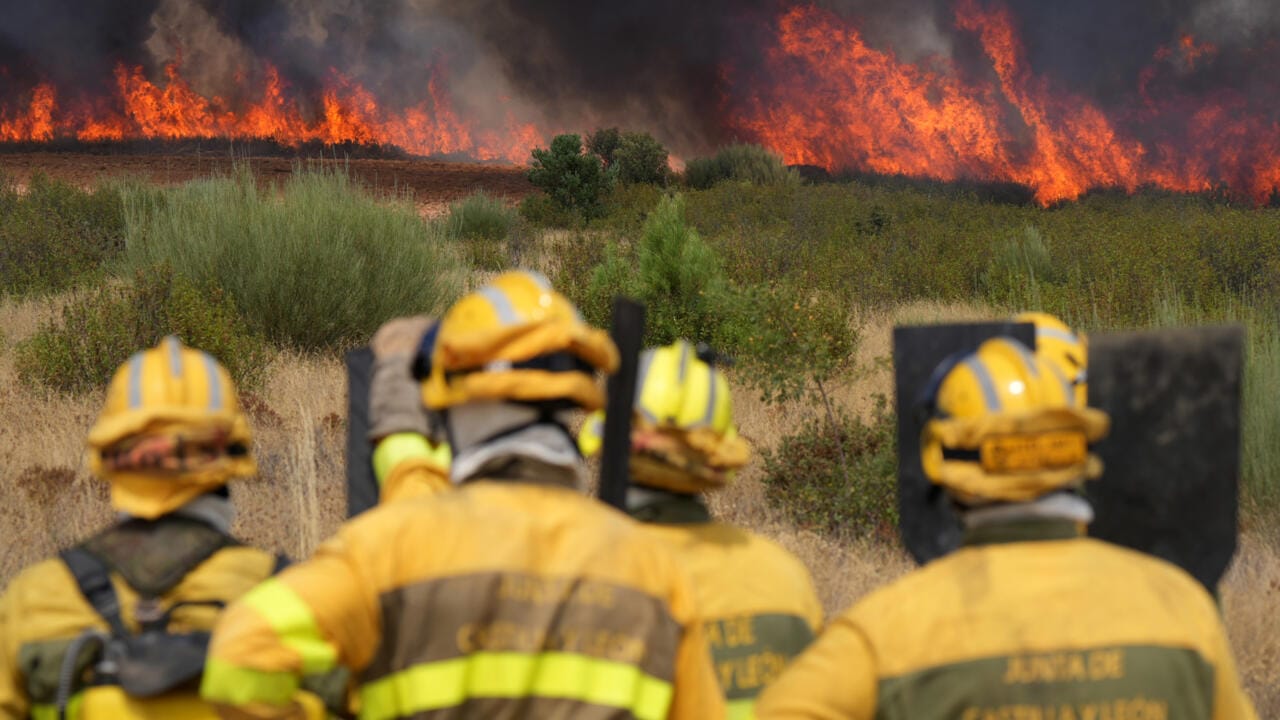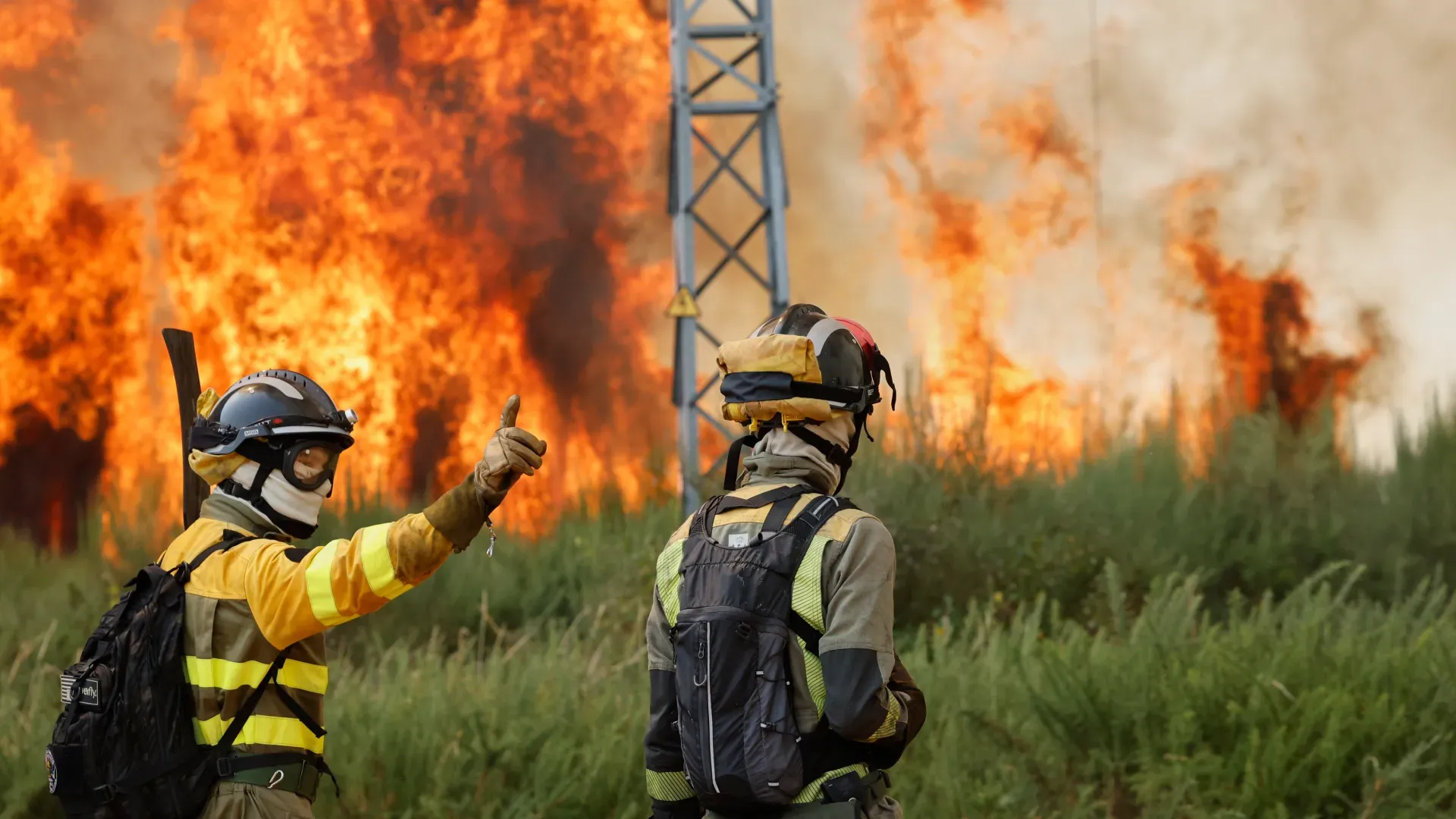Spain's 2025 Wildfire Crisis: A Nation on Fire Amid a Climate Emergency
As Spain battles its worst wildfire season in over two decades, Prime Minister Pedro Sánchez declares a Civil Protection Emergency.

Written by Lavanya, Intern, Allegedly The News
BARCELONA, SPAIN, August 20, 2025
The air across much of Spain is thick with smoke, not just from the immediate blazes but from the acrid taste of a devastating reality. The summer of 2025 has become a grim landmark, a season of unprecedented destruction where raging infernos have consumed over 382,000 hectares, more than double the area burned in Spain in all of 2024. As the flames ravaged the provinces of Galicia, Castilla y León, and Extremadura, Prime Minister Pedro Sánchez made a critical announcement: a nationwide Civil Protection Emergency. This was no routine declaration; it was a powerful signal that the nation's traditional systems were being stretched to their breaking point, and that the crisis, driven by a relentless climate emergency, had entered a new, more dangerous phase.
The Anatomy of a State of Emergency: What Sánchez’s Declaration Means
On August 19, 2025, Prime Minister Pedro Sánchez visited a firefighting command post in Cáceres, a region heavily impacted by the fires. It was there that he officially announced the government would declare a Civil Protection Emergency. This is a significant escalation from a regional-level response. Under Spanish law, specifically Law 17/2015 on the National Civil Protection System, this declaration allows the central government to fully assume the coordination of all emergency services.
This move has a number of immediate and critical implications. First and foremost, it activates the full resources of the Military Emergency Unit (UME), a specialized branch of the Spanish Armed Forces dedicated to disaster response. The UME, which had already deployed over 1,400 personnel, saw its numbers surge to nearly 2,000 to combat the blazes. Secondly, it fast-tracks logistical and financial aid, cutting through bureaucratic red tape to provide immediate compensation to those who have lost homes, businesses, and agricultural land. It allows for the rapid mobilization of aerial assets from other Spanish regions and facilitates requests for international assistance through the EU Civil Protection Mechanism. This year, Spain has already received aerial assets from France and the Netherlands, a clear sign that the crisis has surpassed national capacity.
The declaration is an acknowledgement that the scale of the fires- simultaneous, widespread, and rapidly-spreading- requires a unified, national-level command structure to prevent resources from being overextended in one area at the expense of another. It’s a legal and tactical response to a problem that regional governments, for all their efforts, could not manage alone.

The Climate Verdict: A Heatwave of Unprecedented Proportions
The root cause of Spain’s catastrophic wildfire season is, without a doubt, climate change. Europe is warming at more than twice the global average, and 2025 has been a year of relentless, punishing heat. According to data from the Spanish national weather agency AEMET, temperatures have exceeded 44°C in parts of the country, with southern Spain reaching as high as 45.8°C. This has been compounded by a prolonged and severe drought. The heat and lack of rainfall have turned vast stretches of forest, brush, and farmland into a colossal tinderbox, primed for ignition.
This is a classic "fire triangle" scenario, where the three components of fire—heat, oxygen, and fuel- are all present in dangerous abundance. As fire ecologists and government officials have noted, while lightning strikes or human negligence may spark a blaze, the environment is the true accelerator. A key factor this year has been the significant accumulation of dry, flammable vegetation, a direct result of both the drought and the increasing depopulation of rural Spain. As traditional agricultural practices like grazing and controlled burning have declined, the forests have become overgrown with an unprecedented fuel load.
The Copernicus Atmosphere Monitoring Service (CAMS) has painted a grim picture, reporting that Spain’s total wildfire emissions for 2025 have already reached the highest annual total in its 23 years of data. This vertical increase in emissions in just a few weeks reflects the extraordinary intensity and scale of the blazes, which are burning hotter and faster than in previous years, creating their own unpredictable and dangerous weather patterns.
A Multilayered Battle: Resources, Strategies, and the Human Factor
Fighting these fires is a herculean task. The response is a complex blend of air and ground operations, coordinated through a national command center. At the peak of the crisis, Spain had over 1,900 military personnel from the UME deployed, along with thousands of regional firefighters and volunteer units. The skies were filled with water-bombing planes and helicopters, some operating under the EU’s rescEU program.
However, the sheer speed and ferocity of the fires present immense challenges. Fire whirls, a phenomenon of rotating columns of fire, have been reported in some regions, making the blazes highly erratic and difficult to contain. Strong winds, such as the Tramontane and Mistral, have fanned the flames, causing them to spread at incredible speeds, sometimes over 20 km/h. This has forced urgent evacuations and tactical retreats, putting firefighters' lives at constant risk.
Beyond the environmental factors, a significant portion of the crisis is rooted in human action. Spanish authorities have confirmed that over 90% of wildfires are human-caused, whether through negligence, accidental sparks, or outright arson. The Civil Guard has arrested 23 individuals and is investigating 89 more on suspicion of starting fires. This criminal element adds a layer of complexity, demanding not just a firefighting response but also a focused effort on public awareness and law enforcement to prevent future blazes.
Ecological and Economic Fallout: The Scars Left Behind
The long-term impact of these fires will be felt for generations. Ecologically, the damage is incalculable. Spain is one of Europe’s most biodiverse countries, with a rich tapestry of ecosystems. The fires have incinerated thousands of hectares of protected natural parks, destroying habitats for countless species. Birds, including eagles and vultures, have been particularly vulnerable, with many perishing from smoke inhalation or losing their nests. Small mammals, reptiles, and amphibians have little chance of escape, with entire populations wiped out.
The loss of forests will lead to severe soil erosion, particularly in mountainous regions, increasing the risk of flash floods and landslides in the coming rainy season. This, in turn, can lead to desertification and long-term land degradation. The economic toll is equally staggering. The fires have decimated the agricultural sector, with losses of crops and livestock running into the millions of euros. Tourism, a cornerstone of the Spanish economy, has also taken a hit, as popular hiking routes and scenic areas are closed and the air quality deteriorates. Infrastructure, including the high-speed rail line between Madrid and Galicia and numerous roads, has been severely disrupted, causing further economic strain.
The human side is perhaps the most tragic. Thousands have been evacuated, many watching from a distance as their homes and livelihoods were consumed by flames. The emotional and psychological trauma of these events cannot be understated. The loss of four firefighters this season is a sobering reminder of the ultimate price paid by those on the front lines.

A Continental Wake-Up Call: Spain in a Broader European Context
Spain’s crisis is not an anomaly but a harbinger of a new reality across Europe. In 2025, from Portugal and France to Italy, Greece, and Turkey, the continent has been gripped by simultaneous, record-breaking wildfires. According to the European Forest Fire Information System (EFFIS), over 439,568 hectares have burned across EU countries this year, an area larger than Luxembourg and more than double the average for the past 19 years.
This shared experience has highlighted the urgent need for a more cohesive, continent-wide strategy for climate adaptation and disaster response. While the EU Civil Protection Mechanism provides vital mutual aid, the scale of the crisis suggests that a more fundamental shift is required. The EU and its member states must invest heavily in fire prevention, including sustainable forest management, and embrace new technologies to combat the escalating threat.
The Path Forward: From Reaction to Proactive Resilience
Spain's path to recovery and future resilience must be a multi-pronged approach that moves beyond reactive firefighting.
A Call for a National Pact
Prime Minister Sánchez’s proposal for a "big nationwide pact for the mitigation and adaptation to the climate emergency" is a crucial step. This pact must unite all levels of government, national, regional, and local, as well as the private sector, scientific community, and civil society. It needs to focus on a long-term strategy for land management, reforestation, and the creation of fire-resistant buffer zones around communities.
Embracing Technological Innovation
Technology will play a pivotal role in Spain’s future fire prevention strategy. Experts are advocating for the widespread adoption of AI-based monitoring systems that can detect fires in their earliest stages. Systems like those using satellite imagery and AI-powered cameras on fire towers can analyze vast amounts of data in real-time, identifying the first wisp of smoke or a sudden temperature spike long before a human can. Drones equipped with thermal sensors can patrol high-risk areas, providing critical intelligence to ground crews. These innovations are not a replacement for traditional methods, but a force multiplier that can drastically reduce response times and save lives and property.
Rethinking Land Use and Forest Management
The current crisis has underscored the failure of Spain’s traditional approach to land management. The depopulation of rural areas has led to overgrown forests and a dangerous buildup of fuel. The future must involve a revitalization of these landscapes through controlled burns, the creation of strategic fire breaks, and the promotion of a circular rural economy based on sustainable forestry and extensive livestock farming. This requires significant investment, but the cost of inaction, as seen in 2025, is far greater.
Why this Matters: A Final Word
The 2025 Spanish wildfire crisis is a defining moment, not just for Spain, but for a world on the brink of a climate catastrophe. It is a sobering, fiery manifestation of scientific warnings that have long been ignored. The human cost, the grief, displacement, and loss of life, is a powerful and tragic testament to the need for urgent action. We are no longer debating a future threat; we are living the consequences today. The question is no longer if we will face these crises, but how we will respond. Spain’s declaration of a Civil Protection Emergency is a move of necessity, but the true test of a nation’s resilience lies in the long-term actions it takes to prevent the next one. This crisis is an urgent call to action, demanding a fundamental reordering of our priorities, from short-term economic gains to long-term climate survival.
Answering the New Questions
- How can the Spanish government incentivize and support the repopulation of rural areas to create a new generation of land managers and fire prevention stewards?
- What global framework can be established to ensure that nations most affected by climate-driven disasters receive adequate, rapid, and sustainable international aid, moving beyond ad-hoc assistance?
Sources
Data and statistics are sourced from the European Forest Fire Information System (EFFIS), the Copernicus Atmosphere Monitoring Service (CAMS), and the Spanish national weather agency (AEMET). Information on the legal framework of civil protection comes from Spanish Law 17/2015. Details on the government's response and official statements are from verified press releases and public addresses by Spanish officials.




